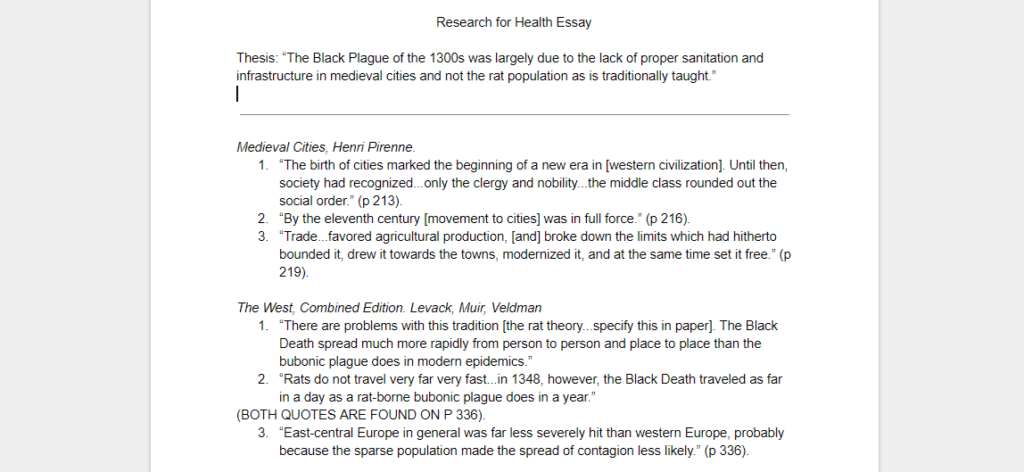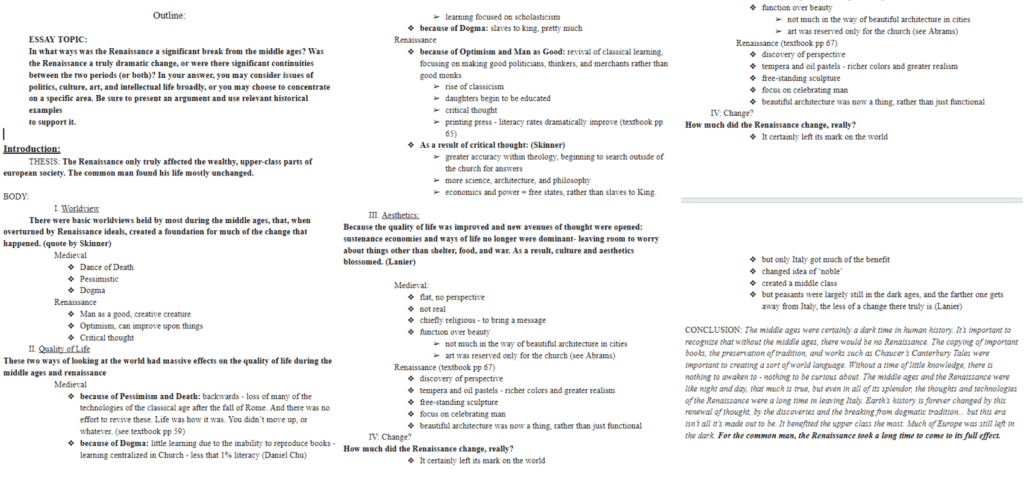Research papers.
Unless you’re a weirdo like me, you probably dread them. When I was in college, depending on the class, I even dreaded these.
It’s the sort of project that can leave even the most organized student quaking in their boots, staring at the assignment like they’re Luke Skywalker and it’s the Death Star.
You have to pick a broad topic, do some in-depth research, hone in on a research question, and then present your answer to that question in an interesting way. Oh, and you have to use citations, too.
How on earth are you supposed to tackle this thing?
Fear not, for even the Death Star had weaknesses. With a well-devised plan, some courage, and maybe a little help from a few midichlorians, you can conquer your research paper, too.
Let’s get started.
1. Pick a Topic
And pick one that interests you. This is not up for debate.
You and this topic are going to be spending a lot of time together, so you might as well pick something you like, or, at the very least, have a vague interest in. Even if you hate the class, there’s probably at least one topic that you’re curious about.
Maybe you want to write about “mental health in high schools” for your paper in your education class. That’s a good start, but take a couple steps to hone your idea a little further so you have an idea of what to research. Here’s a couple of factors to look at when you want to get more specific:
- Timeframe: What are the most important mental health issues for high schoolers that have come up in the last five years?
- Location: How does the mental health of students in your area compare to students in the next state (or country) over?
- Culture or Group: How does the mental health of inner-city students compare to those in the suburbs or places like Silicon Valley?
- Solution: If schools were to make one change to high schools to improve the well-being of their students, what would be most effective, and why?
It’s good to be clear about what you’re researching, but make sure you don’t box yourself into a corner. Try to avoid being too local (if the area is a small town, for example), or too recent, as there may not be enough research conducted to support an entire paper on the subject.
Also, avoid super analytical or technical topics that you think you’ll have a hard time writing about (unless that’s the assignment…then jump right into all the technicalities you want).
You’ll probably need to do some background research and possibly brainstorm with your professor before you can identify a topic that’s specialized enough for your paper.
At the very least, skim the Encyclopedia Britannica section on your general area of interest. Your professor is another resource: use them! They’re probably more than happy to point you in the direction of a possible research topic.
Of course, this is going to be highly dependent on your class and the criteria set forth by your professor, so make sure you read your assignment and understand what it’s asking for. If you feel the assignment is unclear, don’t go any further without talking to your professor about it.
2. Create a Clear Thesis Statement
Say it with me: a research paper without a thesis question or statement is just a fancy book report.
All research papers fall under three general categories: analytical, expository, or argumentative.
- Analytical papers present an analysis of information (effects of stress on the human brain)
- Expository papers seek to explain something (Julius Caesar’s rise to power)
- Argumentative papers are trying to prove a point (Dumbledore shouldn’t be running a school for children).
So figure out what sort of paper you’d like to write, and then come up with a viable thesis statement or question.
Maybe it starts out looking like this:
- Julius Caesar’s rise to power was affected by three major factors.
Ok, not bad. You could probably write a paper based on this. But it’s not great, either. It’s not specific, neither is it arguable. You’re not really entering any sort of discussion.
Maybe you rework it a little to be more specific and you get:
- Julius Caesar’s quick rise to power was a direct result of a power vacuum and social instability created by years of war and internal political corruption.
Better. Now you can actually think about researching it.
Every good thesis statement has three important qualities: it’s focused, it picks a side, and it can be backed up with research.
If you’re missing any of these qualities, you’re gonna have a bad time. Avoid vague modifier words like “positive” and “negative.” Instead use precise, strong language to formulate your argument.
Take this thesis statement for example:
- “High schools should stop assigning so much homework, because it has a negative impact on students’ lives.”
Sure, it’s arguable…but only sort of. It’s pretty vague. We don’t really know what is meant by “negative”, other than “generically bad”. Before you get into the research, you have to define your argument a little more.
Revised Version:
- “High schools in the United States should assign less homework, as lower workloads improve students’ sleep, stress levels, and, surprisingly, their grades.”
When in doubt, always look at your thesis and ask, “Is this arguable?” Is there something you need to prove? If not, then your thesis probably isn’t strong enough. If yes, then as long as you can actually prove it with your research, you’re golden.
Good thesis statements give you a clear goal. You know exactly what you’re looking for, and you know exactly where you’re going with the paper. Try to be as specific and clear as possible. That makes the next step a lot easier:
3. Hit the Books
So you have your thesis, you know what you’re looking for. It’s time to actually go out and do some real research. By real research, I mean more than a quick internet search or a quick skim through some weak secondary or tertiary sources.
If you’ve chosen a thesis you’re a little unsteady on, a preliminary skim through Google is fine, but make sure you go the extra mile. Some professors will even have a list of required resources (e.g. “Three academic articles, two books, one interview…etc).
It’s a good idea to start by heading to the library and asking your local librarian for help (they’re usually so excited to help you find things!).
Check your school library for research papers and books on the topic. Look for primary sources, such as journals, personal records, or contemporary newspaper articles when you can find them.
As you’re starting your research, create some kind of system for filing helpful quotes, links, and other sources. I preferred it to all be on one text document on my computer, but you could try a physical file, too.
In this text document, I start compiling a list of all the sources I’m using. It tends to look like this:

Remember that at this point, your thesis isn’t solid. It’s still in a semi-squishy state. If your research starts to strongly contradict your thesis, then come up with a new thesis, revise, and keep on compiling quotes.
The more support you can find, the better. Depending on how long your paper is, you should have 3-10 different sources, with all sorts of quotes between them.
Here are some good places to look for reputable sources:
- Google Scholar
- Sites ending in .edu, .org, or .gov. While it’s not a rule, these sites tend to represent organizations, and they are more likely to be reputable than your run-of-the-mill .com sites
- Your school library. It should have a section for articles and newspapers as well as books
- Your school’s free academic database
- Online encyclopedias like Britannica
- Online almanacs and other databases
As you read, analyze your sources closely, and take good notes. Jot down general observations, questions, and answers to those questions when you find them. Once you have a sizable stack of research notes, it’s time to start organizing your paper.
4. Write an Outline
Even if you normally feel confident writing a paper without one, use an outline when you’re working on a research paper.
Outlines basically do all the heavy lifting for you when it comes to writing. They keep you organized and on track. Even if you feel tempted to just jump in and brain-dump, resist. You’ll thank me later.
Here’s how to structure an outline:

You’ll notice it’s fairly concise, and it has three major parts: the introduction, the body, and the conclusion. Also notice that I haven’t bothered to organize my research too much.
I’ve just dumped all the relevant citations under the headings I think they’ll end up under, so I can put in my quotes from my research document later as they fit into the overall text.
Let’s get a little more in-depth with this:
The Introduction
The introduction is made up of two main parts: the thesis and the introduction to the supporting points. This is where you essentially tell your reader exactly what sort of wild ride they’re in for if they read on.
It’s all about preparing your reader’s mind to start thinking about your argument or question before you even really get started.
Present your thesis and your supporting points clearly and concisely. It should be no longer than a paragraph or two. Keep it simple and easy to read.
Body Paragraphs
Okay, now that you’ve made your point, it’s time to prove it. This is where your body paragraphs come in. The length of this is entirely dependent on the criteria set by your professor, so keep that in mind.
However, as a rule, you should have at least three supporting points to help defend, prove, or explain your thesis. Put your weakest point first, and your strongest point last.
Conclusion
This doesn’t need a lot of outlining. Basically, take your introduction outline and copy it over. Your conclusion should be about a paragraph long, and it should summarize your main points and restate your thesis.
There’s also another key component to this outline example that I haven’t touched on yet:
Research and Annotations
Some people like to write first, and annotate later. Personally, I like to get my quotes and annotations in right at the start of the writing process.
I find the rest of the paper goes more smoothly, and it’s easier to ensure that I’ve compiled enough support for my claim. That way, I don’t go through all the work of writing the paper, only to discover that my thesis doesn’t actually hold any water!
As a general rule, it’s good to have at least 3-5 sources for every supporting point. Whenever you make a claim in your paper, you should support it with evidence.
Some professors are laxer on this, and some are more stringent. Make sure you understand your assignment requirements really, really, really well. You don’t want to get marked down for missing the correct number of sources!
At this stage, you should also be sure of what sort of format your professor is looking for (APA, MLA, etc.), as this will save you a lot of headache later.
When I was in college, some professors wanted in-text parenthetical citations whenever I made a claim or used my research at all. Others only wanted citations at the end of a paragraph. And others didn’t mind in-text citations at all, so long as you had a bibliography at the end of your entire paper.
So, go through your outline and start inserting your quotes and citations now. Count them up. If you need more, then add them. If you think you have enough (read: your claims are so supported that even Voldemort himself couldn’t scare them), then move on to the next step:
5. Write the First Draft
Time to type this thing up. If you created a strong enough outline, this should be a breeze. Most of it should already be written for you. All you have to do at this point is fill it in. You’ve successfully avoided the initial blank-screen panic.
Don’t worry too much about grammar or prose quality at this point. It’s the rough draft, and it’s not supposed to see the light of day.
I find it helpful to highlight direct quotes, summaries, paraphrases, and claims as I put them in. This helps me ensure that I never forget to cite any of them.
So, do what you’ve gotta do. Go to a studious place or create one, put on an awesome playlist, close your social media apps, and get the work done.
Once you’ve gotten the gist of your paper down, the real work begins:
6. Revise Your Draft
Okay, now that you’ve word-vomited everywhere in a semi-organized fashion, it’s time to start building this thing into a cohesive paper. If you took the time to outline properly, then this part shouldn’t be too difficult.
Every paper has two editing stages:the developmental edit, and the line edit.
The developmental edit (the first one, at least) is for your eyes only. This is the part where you take a long, hard look at your paper and ask yourself, “Does this make sense, and does it accomplish what I want it to accomplish?” If it does, then great. If it doesn’t, then how can you rearrange or change it so that it does?
Here are a few good questions to ask yourself at this stage:
- Is the paper well-organized, and does it have a logical flow of thought from paragraph to paragraph?
- Does your thesis hold up to the three criteria listed earlier? Is it well supported by your research and arguments?
- Have you checked that all your sources are properly cited?
- How repetitive is the paper? Can you get rid of superlative points or language to tighten up your argument?
Once you’ve run the paper through this process at least once, it’s time for the line edit. This is the part where you check for punctuation, spelling, and grammar errors.
It helps to let your paper sit overnight, and then read it out loud to yourself, or the cat, or have a friend read it. Often, our brains know what we “meant” to say, and it’s difficult for us to catch small grammatical or spelling errors.
Here are a couple more final questions to ask yourself before you call it a day:
- Have you avoided filler words, adverbs, and passive voice as much as possible?
- Have you checked for proper grammar, spelling, and punctuation? Spell-checker software is pretty adept these days, but it still isn’t perfect.
If you need help editing your paper, and your regular software just isn’t cutting it, Grammarly is a good app for Windows, Mac, iOS, and Chrome that goes above and beyond your run-of-the-mill spell-checker. It looks for things like sentence structure and length, as well as accidental plagiarism and passive tense.
7. Organize Your Sources
The paper’s written, but it’s not over. You’ve still got to create the very last page: the “works cited” or bibliography page.
Now, this page works a little differently depending on what style your professor has asked you to use, and it can get pretty confusing, as different types of sources are formatted completely differently.
The most important thing to ensure here is that every single source, whether big or small, is on this page before you turn your paper in. If you forget to cite something, or don’t cite it properly, you run the risk of plagiarism.
I got through college by using a couple of different tools to format it for me. Here are some absolute life-savers:
- EasyBib – I literally used this tool all throughout college to format my citations for me, it does all the heavy lifting for you, and it’s free.
- Microsoft Word – I honestly never touched Microsoft Word throughout my college years, but it actually has a tool that will create citations and bibliographies for you, so it’s worth using if you have it on your computer.
Onwards: One Step at a Time
I leave you with this parting advice:
Once you understand the method, research papers really aren’t as difficult as they seem. Sure, there’s a lot to do, but don’t be daunted. Just take it step by step, piece by piece, and give yourself plenty of time. Take frequent breaks, stay organized, and never, ever, ever forget to cite your sources. You can do this!
Good luck!
Looking for tools to make the writing process easier? Check out our list of the best writing apps.
Image Credits: featured


